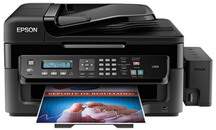


Colour prints were slow, though, with our 24-page test appearing at just 2.4ppm. The L555 lived up to Epson's modest quoted speeds, reaching 8.9 pages per minute (ppm) on our text test, or a decent 16.9ppm when switched to draft quality. It supports wireless, but not wired networking, and neither the 30-page automatic document feeder nor the printer support automatic duplexing (double-sided scans or prints). On-device functions such as fax and photocopies are controlled with conventional buttons rather than a touchscreen, and it has no USB host port for direct prints or scans. Novel ink arrangement aside, the L555 is a very ordinary four-in-one MFP that seems little better than entry level. Such low costs are to be applauded, but spending more time with the L555 made us cut our celebrations short.

By our calculations, that gives the L555 running costs of roughly 0.6 pence for each page of text and graphics, which is about one-tenth of what we'd expect from a competitive small office MFP. Epson quotes a huge 4,000-page yield for the black ink, and 6,500 pages for each of the colours, yet each bottle has a suggested retail price of just £8. Each bottle holds 70ml, which is at least four times what we'd expect in a typical high capacity cartridge. Subsequently a new printer takes about 20 minutes to prime itself.Įpson says that the L555 comes with enough ink for about two years' use, which seems plausible. It's a bit daunting, and there's no physical keying or other foolproof system to prevent you filling a tank with the wrong ink, but we managed to transfer all four colours without spilling a drop. Setting up this printer involves unhooking the tank unit, lying it on its back and filling each of the compartments from the supplied ink bottles. Best printer deals 2022: Our favourite discounts on inkjet, laser and all-in-one printers


 0 kommentar(er)
0 kommentar(er)
